#something something the parallels between their poses in both scenes cannot be a coincidence
Explore tagged Tumblr posts
Text


Time and Again
(screenshots redraws/studies)
#something something the parallels between their poses in both scenes cannot be a coincidence#shading was a slight rush job because they're supposed to be sketchy but i am surprisingly happy with both#especially the first one because i thrive on angst#legend of zelda#breath of the wild#tears of the kingdom#link#zelda#master sword#zelink
235 notes
·
View notes
Text
A Comparrison between Az’s Chapter and Cassian’s Chapters in Acofas
Today I found myself inspired by @thereaderspeaks ‘s post and what I had to add about it, to write this long-ass post comparing Az’s chapter in Acosf to Cassian’s three chapters in Acofas.
@rhyssescups does an amazing job in this post (and @psychee92 in this one) of comparing Az’s chapter to Cassian’s POV in Wings and Embers. I’ll also attach @psychee92 ‘s comparison of both batboys’ attitudes after their respective solstices. But I’m going to concentrate on Az’s POV and Acofas rather than Wings and Embers.
There are a LOT of things in common, so when you add the posts linked above to this one, you’ll see how Azriel’s emotions and his interaction with Gwyn mirror those of Cassian. Everyday I find more peace of mind regarding Elriel.
Before I begin, I want to clarify that Emerie is not in Wings and Embers, but on Cassian’s perspective in Acofas. I had seen many people on Tumblr and on Twitter saying (by mistake) that she’s in W&E, so I wanted to point that out. It is Mor who is mentioned in W&E. How Cassian does not want to tell her about Nesta, etc. For more on that, check out the links I attached above.
There are many elements that Cassian and Azriel share in their chapters and I decided to divide them into categories. I’ll support them with quotes so that we have the receipts. With that said…
Let’s get started!
1. Distance
In both instances there was something that separated the couples and caused distance.
In Cassian’s case it was post-war-Nesta and even Cassian himself (it was pride that kept him ignoring her all through the party until he couldn’t take it anymore and ran after her, simple as that):

In Azriel’s case it was his understanding of what he feels for Elain and the fact that she has a mate. But also, let’s add Rhys’s order as a new element that will cause distance.
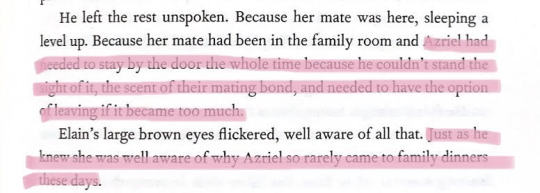



2. Emotions
Cassian did not allow himself to think about Nesta because of the feelings that stirred up in him.
Anger, passion, confusion.

And Azriel…
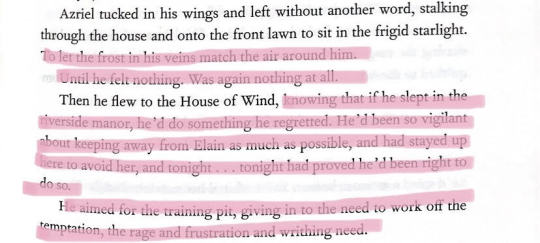
Well, well, well... What do we have here?
Anger, passion, confusion.
He was ready to spar it out of his system, too, like Cassian.
3. Something the batboys associate with their mate Archeron sister
I noticed that in both cases, Cass and Az had given their girls something that they associated with them, be it material or other.
For example, Cassian’s was names for Nesta’s poses.
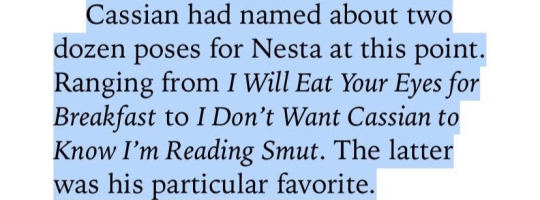
He saw Nesta stand in any particular way and if it was something she repeated he gave that pose a name. It is something he associates with her.
In Azriel’s case, we know he gives Elain a rose necklace.

Roses signify Elain because of what she does: gardening; But also, it could simply represent them. Their way of spending time together (here’s a post of different refences of Elriel in the garden by @silver-flames) and their relationship that has been slowly blooming in secret, like how that charm shines with colors when it’s in the light, but looks ordinary in the dark.
4. The batboys hurting the sisters
In both POVs the Illyrians hurt the Archerons.
Cassian does it out of anger. Because Nesta kept rejecting him. Instead of holding his tongue, like any mature person should, he tells her something that destroys her (we know by her reaction).
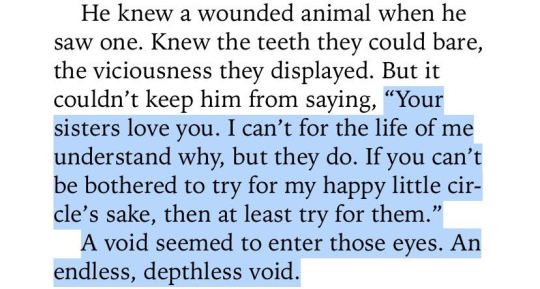
See how her eyes go empty?
Well, in his chapter, Azriel hurts Elain, too, though it pains him as much as it pains her because he did not do it intentionally.


5. The sisters rejecting/returning the gifts
Nesta rejects Cassian’s gift, though I wouldn’t have taken it either after what he told her. This quote comes from before his insult, but my point is that she left without taking the gift.

Also, notice how Cassian hadn’t wanted to give Nesta her present in front of the others, something that Azriel does, too, though for different reasons. Cassian had feared rejection and had been waiting for her to approach him.
Azriel had not given Elain her present because Lucien, her mate, was there.

And of course, Elain returns her gift after Azriel left her standing in the hall with the words “this was a mistake.” I wouldn’t have stayed with that necklace either, not when it reminded me of that moment.
6. Regifting/Comparing
Something particular that happens in both characters’ PoV is the regifting of the objects the batboys used to relate to their girls. I do not think they are necessarily wrong, just that it happens.
Cassian uses the name of one of Nesta’s poses to describe Emerie.
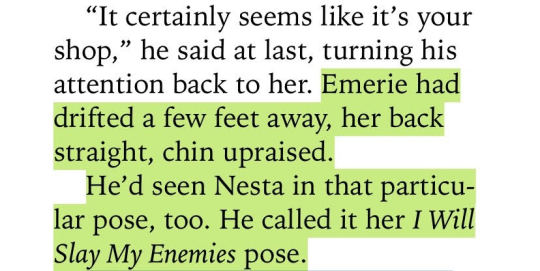
He also compares her way of speaking and the look in her eyes to that of Nesta.


Azriel regifts the necklace that represents Elain to Gwyn (though he doesn’t give it to her personally, just hands it to Clotho for her to do it), and describes her with the same quote he used on the necklace (Elriel).
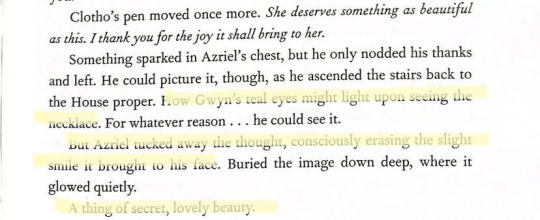
I have my own theory on why the thought of her smile makes him smile. Soon I will explain.
7. Getting rid of the gifts (decisions made in haste)
Cassian being all impulsive and throwing the very expensive and extremely unique gift to the Sidra:
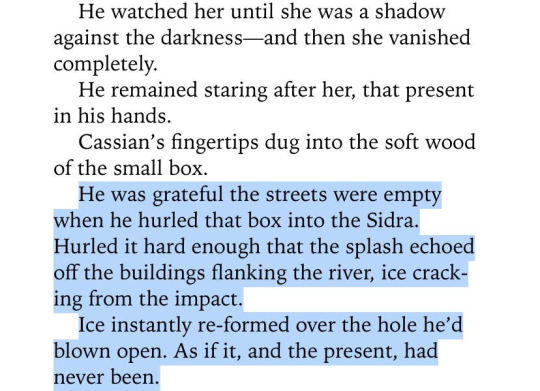
Gotta love our hotheaded overgrown bat. (My baby!! <3)
Then, we have Az making the dumb decision of regifting the present because somehow he couldn’t get rid of it (symbolism but not the post for it).



He was in a bad place when he made the decision, and even Clotho points out that his eyes are sad.
The quote in purple is important to note. The theory about Clotho not giving Gwyn the necklace? That line is good for it. The fact that he told Clotho to give the necklace to anyone as long as he didn’t have it and the sadness she gleaned in his eyes is enough for her to know there is more to it than what he tells her.
I also want to point out that we know for a fact that Cassian regretted getting rid of the present and that he knows he had been foolish that night. So, considering how parallel to each other these chapters are, I’m sure that Azriel will, too.
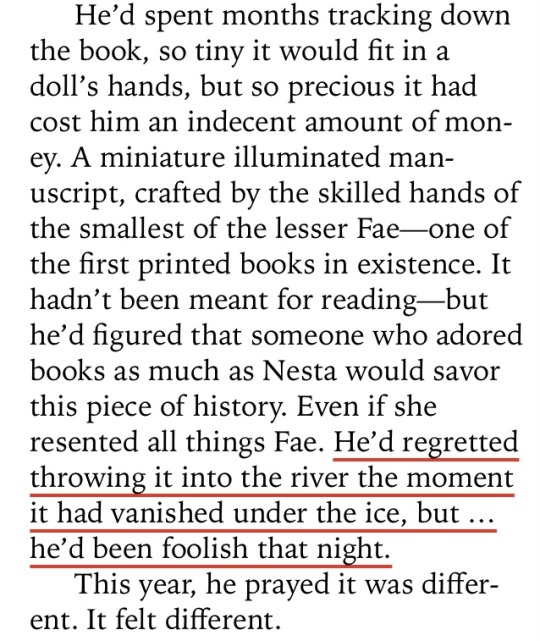
8. Distraction/Consolation (Aftermath)
I think it is important to highlight how Cassian got to the Townhouse late and was followed by a worried Mor, who most likely consoled him after his disastrous evening with Nesta...

...and compare it to how Azriel had needed to release unspent energy and was successfully distracted from his bad juju by the short lesson he gave to Gwyn:

He straight up says he’s thankful for the distraction. That was what the whole convo had been for him -in a good sense.
It also aligns super well with @silverlinedeyes ‘s theory of Gwyn being a lightsinger in how they appear to people when they are lost. Gwyn was there when Azriel needed someone (even just to distract him), be it coincidence or not, and that cannot be ignored.
If Gwyn does take on a role in Acotar 5, I think it will have a lot to do with being his friend and confidant (and trainee), someone who will help him figure out what to do about his situation, just like how she unknowingly helped him on solstice.
9. Empathy towards the Valkyries
Another parallel that I found in the chapter is how Cassian felt empathy for Emerie’s situation upon looking at her...


...and how Azriel’s interaction with Gwyn brought about the same reaction:


This is what I was talking about earlier. Notice how he sees her pain and grief and prefers when she’s happy to when she’s sad? Who wouldn’t want that? That is the same mentality I apply to his smile at the thought of her smiling. That he is glad that something would make her happy after what she has been through. Especially after remembering her past (within the last three pages).
10. Emerie and Gwyn’s attitudes
This was super curious for me! Look at how both girls say goodbye to the batboys:

Emerie being a whole independent female, and Gwyn…

All business.
Literally got the same energy from them.
Gwyn finished the convo and continued her practice like the badass warrior that she is. There was no demure glance or cloy blush anywhere. The interaction was not romantic, purely platonic. Just like Emerie’s with Cassian.
11. This interesting parallel:
These two moments that are almost identical:

Cassian tells Emerie to give the Illyrians the clothes he just bought and to tell them it was the High Lord’s gift. He does it because he knows the Illyrians would not accept them if they knew they came from Cassian.
Azriel:
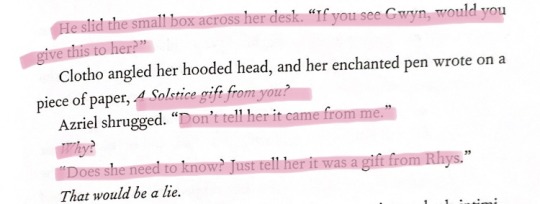
Another one (DJ khaled voice).
“Just tell her it was a gift from Rhys.”
Why does he do that? Because it wasn’t romantic and if Gwyn had known she’d have brought it up in conversation. He just wanted to be rid of it, so he gave it to her, perhaps as a way of thanking her for the distraction yesterday, but nothing more.
“If there’s another priestess here who might appreciate it, give it to them.” He didn’t care who’d have it as long as it wasn’t him.
Conclusion:
(Wings and Embers + Acofas) Cassian = Acosf bonus chapter Azriel
That’s the real formula bestie SJM used and the receipts are here.
Azriel mirrors Cassian in emotions, actions and interactions.
Remember how Nesta Antis began shipping Cass with Emerie after their interaction in Acofas simply because they hated Nesta? Their scene had zero romantic energy, but Nesta Antis still did it.
Well, history repeats itself with Elain.
Regarding Gwyn: So far, I see no build-up to something more than a friendship. Like we explored, Az’s scene with her was similar to Cassian’s with Emerie. The differences lie in that Gwyn is more energetic than Emerie and that Az’s shadows reacted to her power (she has powers, read about it in the lighsinger theory).
There is literally nothing more I can add.
Peace out.

#elriel discussion#elriel endgame#elriel#elain#azriel#elain x azriel#acotar#acotar 5#acosf#acosf spoilers#azriel bonus chapter#wings and embers#acofas#sarah j maas
341 notes
·
View notes
Text
The Underlying Christian Symbolism in Undertale: Asriel’s Messianic Parallels
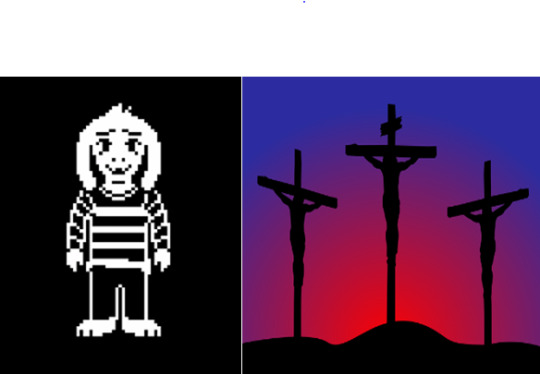
Yesterday we talked about the Devil, so today we’re talking about Christ. Or at least, I should say, Christ-like characters in Undertale. I’m referring of course to Asriel Dreemurr. Despite the brevity of time he actually spends on screen, Asriel is easily one of the most endearing and heartbreaking characters in the entire game, and for Undertale, that’s saying something. Judging from the amount of fan art and fan fictions dedicated to him, he’s left more of an impact on the fanbase than any other character with the exception of Sans. It’s not hard to see why; many consider him to be the purest embodiment of love, pacifisms, and selflessness in the game, yet he’s been dealt the most tragic lot of any of the characters. Effectively, Asriel is the one person you cannot save. But beyond the obvious general parallels of the two figures, is this there something more to this sweet and tragic goat boy than meets the eye?
I’m of the opinion there is. Finding religious subtexts in video is always a slippery and volatile subject, but in this case, I can’t shake the feeling that the parallels are too pointed to ignore. I don’t think Asriel was meant to be a direct analogue to Jesus in the way characters such as Aslan from the Chronicles of Narnia are. But I find it hard to believe that his character wasn’t at least inspired by Christ, and hopefully by the end of this post you’ll see what I mean.
The first encounter we could say we have with Asriel is at the very beginning of the game in the form of Flowey. However, there seems to be some debate amongst the fanbase as to whether Asriel and Flowey can even be considered the same character, so polar opposite are their personalities. King Asgore may look like a devil, but Flowey is the closest thing the Underground has to an actual demon in terms of what he does. Much like the Fallen Child, he often works vicariously through others, using temptation and manipulating to coerce people into furthering his plans. Also like the Fallen Child, Flowey is soulless, and thus incapable of feeling love for others. The “Asriel” side of him only re-emerges in the presence of the souls that allowing him to feel compassion once more. Just for that reason alone, I’m going to be treating Asriel and Flowey as separate characters throughout this post, the same way I would consider the entity we meet at the end of the Genocide Route to be something distinct from the original First Child who fell into the Underground. However, that being said, it’s interesting to note that the first and the being we fight is always either Flowey or Asriel, whether one is doing a pacifist, neutral, or genocide playthrough. One way or another, the Flowey/Asriel entity acts as bookends to the entire game and seems to exist on a more meta level than the rest of the cast, when we listen closely to their dialogue.
First, here are a couple of the more superficial parallels between Asriel and Jesus. Both of them are described as the only naturally born son of a king, but are also described as having adopted siblings, and both are held up as great symbols of hope at their birth. Both at some point claim to be God. Despite this, both of them appear to bring great tragedy and hardship to the lives of all who love them, at least at first. Asriel is very compassionate and gentle to others; the story of how he treated the First Human child could be described as a textbook example of the Good Samaritan. Both figures die unjustly at the hands of their enemies, refusing to fight back despite having the ability to destroy everyone who was harming them. Also, curiously, the name “Asriel” can mean “Prince of God”, in addition to being a portmanteau of the names Asgore and Toriel. This very name is actually used in the Bible for one of the sons of Manasseh, so if it sounds Hebrew in origin, that’s because it is.
From there the similarities start to deepen. Both Asriel and Jesus have prophecies that refer to them. For Asriel, it’s the Delta Rune that’s said to predate written history, according to Gerson. The Delta Rune is probably going to get its own post at some point because of how packed it is with brilliant symbolism, so I’ll try to be brief here.
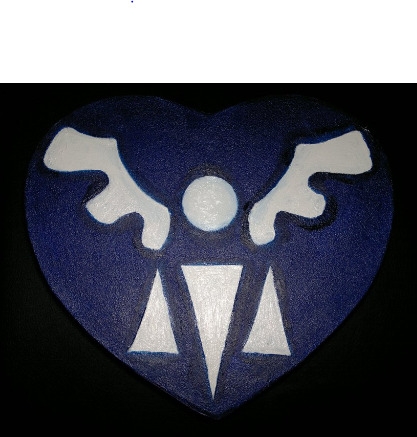
To put it simply, the Delta Rune is the symbol of an “angel” from above who will cause the underground to go empty, whether by freeing all monsters or by killing all of them. There’s some debate as to who exactly this “angel” is, many would believe it was the player, and in the genocide run, it very well might be. On the pacifist, run, however, the “angel” definitely aligns most closely with Asriel, and the reflection of the Delta Rune’s design in his final form is evidence of this (note the location of the triangles on his body) This is really the only prophecy we know of that links to Asriel directly, but it’s still a prophecy nonetheless.

Ultimately, Asriel is the one who breaks the barrier and sets all monsters free from the Underworld. Not only this, but he does so at the cost his own life, giving up the souls and reverting back to a flower. If I really have point out to you why this would be reminiscent of Christ, then this blog probably isn’t your cup of tea. But that’s not all. Right before the barrier is shattered, Asriel’s spite rises off of the ground and takes a very particular stance before committing the act. He begins speaking some inaudible words as the souls rush out of him and a really dramatic guitar riff starts playing in the background. But take a close look at that pose. Does it remind you of anything?
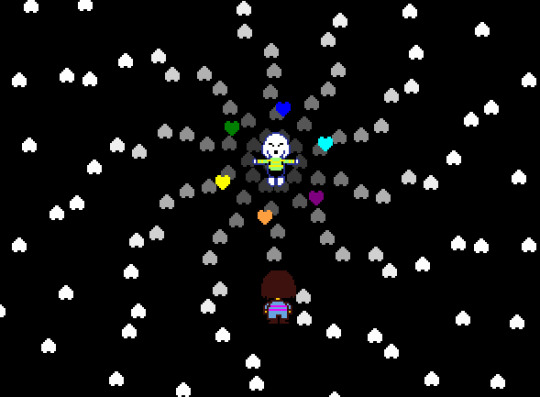
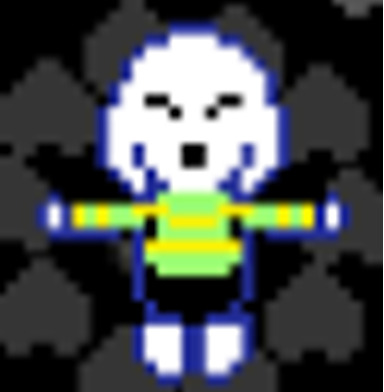
There are some other peculiarities in the following scenes that seem to call back on New Testament imagery. One is the actual depiction of the barrier being shattered. It appears as a white screen cracking in two and the halves separating, before the message “The barrier was destroyed” flashes across the screen. It’s hard to say what exactly most of us were expecting we would see when we witnessed the destruction of the barrier, but I have to imagine that most of us saw this as a very minimalistic approach, almost a letdown, really, to such a dramatic event.
Or was it?
I can’t help but look but look at this picture of the barrier being destroyed and not be a little reminded of Matthew 27:50-51, “And when Jesus had cried out again in a loud voice, he gave up his spirit. At that moment the curtain of the temple was torn in two from top to bottom. The earth shook, the rocks split, and the tombs broke open.”
Anyone who’s done their theological homework knows that the curtain in the Jewish Temple was a symbol of the separation of God’s holiness and the sins of humanity. In effect, it acted as a barrier between man and God. And with the death of Jesus, that barrier of separation is destroyed. This symbolism wasn’t lost on the New Testament writers, it’s actually quite explicit. Ephesians 2:14 reads “For he [Christ] himself is our peace, who has made the two groups one and has destroyed the barrier, the dividing wall of hostility.”
Is this starting to get weird yet? Maybe up to this point, I still that all of this could just be a big coincidence, an unlikely set of parallels to the Bible that a video game happens to exhibit, perhaps because these Biblical archetypes are just so ubiquitously ingrained in our culture. And who knows, maybe that’s all it is.
But there is one more detail.
I don’t remember when exactly it was I began to suspect that Undertale might have religious themes woven into its subtext. But perhaps it was around the point I started noticing the subtle topics of death and resurrection within the story, and their connection to the “soul”. The Fallen Child Chara apparently resurrects at the end of the genocide run (though whether that entity is actually Chara seems doubtful). Also, they appear to be communicating within the mind of Frisk, narrating the events on the screen as they happen, leading some to believe that Frisk is actually the reincarnation of Chara. Asriel himself undergoes a twofold resurrection within the game, first as a soulless flower at the hands of Dr. Alphys, and later back to his full being with the absorption of the human souls.
And then, there are the six other humans who fell underground.
There are a lot of unanswered mysteries in Undertale, but one of the ones I find the most puzzling is the question of what happened to the human souls when Asriel gave them up to break the barrier? Did they dissipate, were they taken to the afterlife, or did something…else…happen to them? There’s a hint in the game, but it raises more questions than answers.
If you go past the throne room in Asgore’s palace, you will find a set of stairs leading to his basement. If you follow them all the way down, you will find this room:
If you try to look into the coffin you find the name of the first human on it, also with the description that it’s empty. By logical extension, the other coffins are the six other children.
If you go back to the basement after having saved Asriel, when the barrier is broken, you find this:

All of the tombs are empty and all save the first one are open.
Let’s go back to Matthew 27 for a second. If we keep reading from where we left off; “…At that moment the curtain of the temple was torn in two from top to bottom. The earth shook, the rocks split, and the tombs broke open. The bodies of many holy people who had died were raised to life. They came out of the tombs after Jesus’ resurrection and after Jesus’ resurrection they went into the holy city and appeared to many people.”
Uncanny, isn’t it? Why are all the coffins open except for the one already stated to be empty? Where are the bodies? And where is the body of the First Child? Are they really dead?
We never get any answers, but if you go to check the coffin again, you’ll find the message “The coffin is empty…? You didn’t notice it before, but there’s something like…mummy wrappings at the bottom of it.”
Most likely these would be grave clothes, or perhaps a shroud. But this seems like an awfully insignificant detail to slip into a room so filled with unanswered questions. All it really tells is that the body isn’t in the coffin anymore. And it wasn’t reburied somewhere else, since the grave clothes were taken off. Does this also sound familiar?
“So Peter and the other disciple started for Jesus’ tomb. Both were running, but the other disciple outran Peter and reached the tomb first. He bent over and looked in at the strips of linen lying there but did not go in. Then Simon Peter came along behind him and went straight into the tomb. He saw the strips of linen lying there, as well as the cloth that had been wrapped around Jesus’ head. The cloth was still lying in its place, separate from the linen. Finally the other disciple, who had reached the tomb first, also went inside. He saw and believed.” (John 20:4-8)
So, what are we to make of this? It’s not uncommon for stories or video games to involve a Messianic archetype, but the detail of symbolism used in this case suggests there might be something more going on with Asriel than your usual stock redeemer character. Coupled with Asriel’s father’s resemblance to Satan, Asriel’s flower alter ego playing a much more actual Satanic character, and the fact that this boy is the one person you CAN’T save, but who essentially dies AFTER resurrecting in the “friendly RPG where no one has to die”, this mystery of Undertale lends itself to some rather confusing, and frankly disturbing, implications.
Stay safe, folks. Until next time, this is Truecantaloupelove, signing off.
8 notes
·
View notes